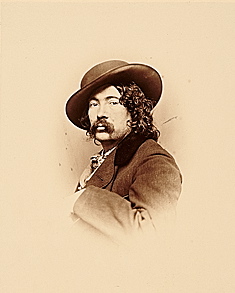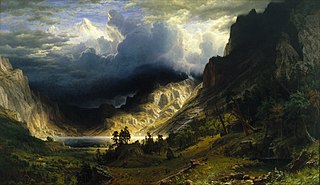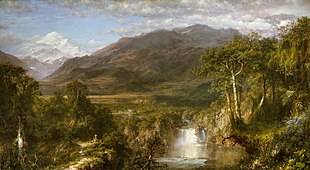
Albert Bierstadt was a German American painter best known for his lavish, sweeping landscapes of the American West. He joined several journeys of the Westward Expansion to paint the scenes. He was not the first artist to record the sites, but he was the foremost painter of them for the remainder of the 19th century.

Thomas Moran was an American painter and printmaker of the Hudson River School in New York whose work often featured the Rocky Mountains. Moran and his family, wife Mary Nimmo Moran and daughter Ruth took residence in New York where he obtained work as an artist. He was a younger brother of the noted marine artist Edward Moran, with whom he shared a studio. A talented illustrator and exquisite colorist, Thomas Moran was hired as an illustrator at Scribner's Monthly. During the late 1860s, he was appointed the chief illustrator for the magazine, a position that helped him launch his career as one of the premier painters of the American landscape, in particular, the American West.

Mount Bierstadt is a 14,065-foot-high (4,287 m) mountain summit in the Front Range of the Rocky Mountains, in the U.S. state of Colorado. The fourteener is located in the Mount Evans Wilderness of Pike National Forest, 9.4 miles (15.1 km) south by east of the Town of Georgetown in Clear Creek County. It was named in honor of Albert Bierstadt, an American landscape painter who made the first recorded summit of the mountain in 1863.

James McDougal Hart, was a Scottish-born American landscape and cattle painter of the Hudson River School.

Martin Johnson Heade was an American painter known for his salt marsh landscapes, seascapes, and depictions of tropical birds, as well as lotus blossoms and other still lifes. His painting style and subject matter, while derived from the romanticism of the time, are regarded by art historians as a significant departure from those of his peers.

William Trost Richards was an American landscape artist. He was associated with both the Hudson River School and the American Pre-Raphaelite movement.

Sanford Robinson Gifford was an American landscape painter and a leading member of the second generation of Hudson River School artists. A highly-regarded practitioner of Luminism, his work was noted for its emphasis on light and soft atmospheric effects.

Thomas Worthington Whittredge was an American artist of the Hudson River School. Whittredge was a highly regarded artist of his time, and was friends with several leading Hudson River School artists including Albert Bierstadt and Sanford Robinson Gifford. He traveled widely and excelled at landscape painting, many examples of which are now in major museums. He served as president of the National Academy of Design from 1874 to 1875 and was a member of the selection committees for the 1876 Philadelphia Centennial Exposition and the 1878 Paris Exposition, both important venues for artists of the day.

The Heart of the Andes is a large oil-on-canvas landscape painting by the American artist Frederic Edwin Church (1826–1900). It depicts an idealized landscape in the South American Andes, where Church traveled on two occasions. Measuring more than five feet high and almost ten feet wide, its New York City exhibition in 1859 was a sensation, establishing Church as the foremost landscape painter in the United States.

In 1859 Albert Bierstadt accompanied Frederick W. Lander on a western expedition. On his return he painted a mountain landscape on a large 6-by-10-foot (1.8-by-3.0-meter) canvas, The Rocky Mountains, Lander's Peak. Following the death of General Lander during the Civil War in 1862, Bierstadt named the peak Lander's Peak. The painting was completed in 1863 and sold in 1865 for $25,000.

A Storm in the Rocky Mountains, Mt. Rosalie is an 1866 landscape oil painting by German-American painter Albert Bierstadt (1830-1902) which was inspired by sketches created on an 1863 expedition.

The Icebergs is an 1861 oil painting by the American landscape artist Frederic Edwin Church. It was inspired by his 1859 voyage to the North Atlantic around Newfoundland and Labrador. Considered one of Church's "Great Pictures"—measuring 1.64 by 2.85 metres —the painting depicts one or more icebergs in the afternoon light of the Arctic. It was first displayed in New York City in 1861, where visitors paid 25 cents' admittance to the one-painting show. Similar exhibitions in Boston and London followed. The unconventional landscape of ice, water, and sky generally drew praise, but the American Civil War, which began the same year, lessened critical and popular interest in New York City's cultural events.

Bierstadt Lake is located in Larimer County, Colorado and within the Rocky Mountain National Park. Near McHenrys Peak and Longs Peak, there are "spectacular views" of the Continental Divide at the lake. The Bierstadt Lake Trailhead is located about 6.5 miles (10.5 km) from the turn-off at U.S. Route 36 into the Rocky Mountain National Park. During the summer, shuttle buses provide transportation to the trailhead.
History of Rocky Mountain National Park began when Paleo-Indians traveled along what is now Trail Ridge Road to hunt and forage for food. Ute and Arapaho people subsequently hunted and camped in the area. In 1820, the Long Expedition, led by Stephen H. Long for whom Longs Peak was named, approached the Rockies via the Platte River. Settlers began arriving in the mid-1800s, displacing the Native Americans who mostly left the area voluntarily by 1860, while others were removed to reservations by 1878.

Valley of the Yosemite is a painting by the German American painter Albert Bierstadt that was completed in 1864. Initially associated with the Hudson River School, Bierstadt rose to prominence for his paintings of the Rocky Mountains, which established him as one of the best painters of the western American landscape. His later paintings of Yosemite were also received with critical acclaim and public praise.

Among the Sierra Nevada, California is an 1868 oil-on-canvas painting by German-American artist Albert Bierstadt which depicts a landscape scene of the Sierra Nevada mountain range in California. Created at his studio in Rome, the painting was exhibited throughout Europe, creating interest in immigration to the United States. Measuring 72 by 120+1⁄8 inches, the painting is a centerpiece of the 19th-century landscape collection at the Smithsonian American Art Museum in Washington, D.C.

The Three Tetons is an 1895 oil painting by Thomas Moran. It depicts Grand Teton and the neighbouring peaks of Middle Teton and South Teton, from the Idaho side. The National Park Service describes Moran as, after Albert Bierstadt, the "other 'grand' painter of the Tetons".

The American Pre-Raphaelites was a movement of landscape painters in the United States during the mid-19th century. It was named for its connection to the Pre-Raphaelite Brotherhood and for the influence of John Ruskin on its members. Painter Thomas Charles Farrer led the movement, and many members were active abolitionists. Their work together was short-lived, and the movement had mostly dissolved by 1870.
Hermann Traugott Louis Fuechsel, also known as Füchsel or Fuchsel, was a German-American landscape painter, and member of the Düsseldorf school and Hudson River School.


















